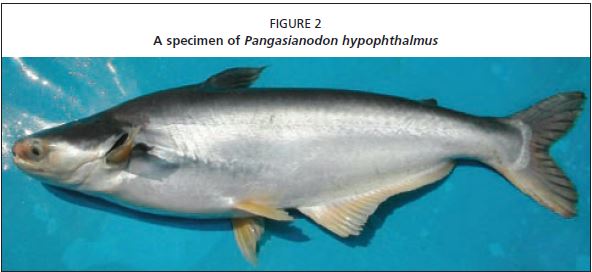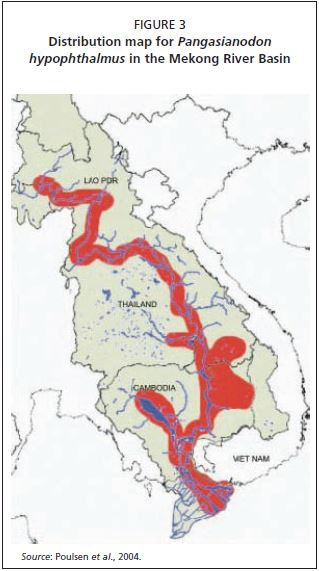DESCRIPTION OF THE SPECIES
Pangasiid catfishes
There are 16 species of Pangasiid catfishes in the Mekong, belonging to four genera (Helicophagus, Pangasianodon, Pangasius and Pteropangasius) (Gustiano, 2003). The group include one of the largest and most conspicuous freshwater species in the world, the Mekong giant catfish (Pangasianodon gigas).
Only two species are currently used in significant numbers in capture-based aquaculture: the river catfish (or Sutchi catfish) (Pangasianodon hypophthalmus) (Figure 2) and Bocourt’s catfish (Pangasius bocourti). Some of the others, particularly Pangasius conchophilus, Pangasius krempfi and Pangasius larnaudiei are also used (Trong, Hao and Griffiths, 2002), but at much smaller scales.
Figure 2
A specimen of Pangasianodon hypophthalmus

The traditional development of capture-based aquaculture was based on Sutchi or river catfish, Pangasianodon hypophthalmus, probably because it is a prolific spawner, which produces a relatively large number of larvae that are easily harvested from the flowing river. Pangasius bocourti on the contrary, lays far fewer eggs and thus it is harder to collect significant numbers of drifting wild fry. They are instead captured when they are older and bigger (i.e. at a total length of around 5 cm) using specialised hooks (Van Zalinge et al., 2002).
All of the Pangasiid species are migratory. Some of them carry out spectacular long distance migrations between feeding habitats, refuge habitats and spawning habitats. The two key species above, for instance, both migrate several hundred kilometres between upstream refuge/spawning habitats and downstream feeding and nursery habitats.
Research programmes are currently working on the domestication and artificial breeding of several species of the group, including Pangasius krempfi and Pangasius larnaudiei, and these may become important aquaculture species in the future. However, since Pangasianodon hypophthalmus and Pangasius bocourti are the main cultured Pangasiid species in the Mekong, they are the main focus of this paper.
Life cycle of Pangasianodon hypophthalmus
The river catfish, Pangasianodon hypophthalmus, occurs throughout the lower Mekong Basin, from the upper reaches along the border between Thailand and Lao People’s Democratic Republic, through Cambodia, to the Mekong delta in Viet Nam (Figure 3). It is however extremely rare in the upper reaches. It has been suggested that there are two or more separate populations, i.e. a small “upper Mekong” population (mainly covering Thailand and Lao People’s
Democratic Republic) and one or more “lower
Figure 3
Distribution map for Pangasianodon hypophthalmus in the Mekong River Basin

Source: Poulsen et al., 2004.
Mekong” population(s), mainly covering southern Lao People’s Democratic Republic, Cambodia and Viet Nam, which is by far the largest population (Poulsen et al., 2004), a hypothesis subsequently supported by recent genetic studies (So, Maes and Volckaert, 2006a; So, Maes and Volckaert, 2006b).
As with all other fishes of the Mekong, the life cycle of Pangasianodon hypophthalmus is intimately synchronized with the annual flood cycle caused by the monsoon. Spawning mainly takes place at the beginning of the monsoon in May-June. For the southern population, the main spawning grounds are believed to be located in the mainstream Mekong in northern Cambodia along a stretch between the two river towns of Kratie and Stung Treng (So, 2005). This stretch of the river is particularly rich in rapids and deep pools and is generally considered a key area for a large proportion of Mekong fishes particularly for spawning, and as a dry season refuge, including most of the Pangasiid species.
The eggs are sticky and are believed to be deposited on roots of certain types of vegetation (Touch, 2000; Van Zalinge et al., 2002). A 10 kilogram individual can produce more than one million eggs (Van Zalinge et al., 2002).
When hatched, the larvae enter the Mekong water column and join a large number of other Mekong fish species in a spectacular, multi-species larval drift downstream towards the Mekong delta, where they enter their nursing grounds on the vast floodplains of the delta and Tonle Sap/Great Lake system. Studies of this larval drift in Viet Nam have identified at least 153 species of fish belonging to 32 families and 10 orders within a period of three months from May to August (Nguyen et al., 2001). Subtle differences in drift patterns probably represent ecological differences between species. For instance, Pangasianodon hypophthalmus is the only species to mainly drift in the surface waters, which makes them easier to capture in large numbers, whereas all other species mainly occur in deeper waters (Hortle et al., 2005).
Pangasianodon hypophthalmus feeds on a variety of items including algae, higher plants, zooplankton and insects. Larger river catfish also eat fruits, crustaceans and fish (Van Zalinge et al., 2002).
Recent genetic studies of Pangasianodon hypophthalmus in Cambodia have indicated that the relatively limited extent of spawning habitats compared with the feeding habitats may have triggered the evolution of up to five “cryptic” (sympatric) populations (So, Maes and Volckaert, 2006b). These populations are believed to use the same spawning habitats, but at separate times (separate spawning “runs”) – whereas at the feeding grounds the populations are mixed (So, Maes and Volckaert, 2006b). In other words, spawning habitats may be the main bottleneck for the populations of Pangasianodon hypophthalmus and are therefore also of critical importance for sustaining the diversity and size of populations.
Life cycle of Pangasius bocourti
Pangasius bocourti has a similar distribution range to Pangasianodon hypophthalmus, and occurs in the Mekong mainstream and larger
tributaries throughout the lower Mekong basin (Poulsen et al., 2004). It also appears to consist of geographically separated and genetically distinct populations, i.e. an upstream population (in northern Thailand and Lao People’s Democratic Republic) and one or more populations downstream in southern Lao People’s Democratic Republic, Cambodia and the Mekong Delta in Viet Nam (Figure 4).
Genetic studies have recently indicated that several distinct sub-populations may exist in the lower Mekong reaches, in Cambodia and Viet Nam, i.e. similar to Pangasianodon hypophthalmus
(So, Maes and Volckaert, 2006a; So, Maes and Volckaert, 2006b). Since it has not yet been possible to sample the earliest larval stages of Pangasius bocourti, genetic sub-structures are much more difficult to detect.
Little is known about the detailed ecology of the species, including its spawning behaviour and migration patterns. It is believed to spawn in the same river stretch in northern Cambodia and have similar migration patterns to Pangasianodon hypophthalmus (Poulsen et al., 2004; So, Volckaert and Srun, 2006). As mentioned above, Pangasius bocourti is less fecund than Pangasianodon hypophthalmus. The main spawning season is also believed to be at the beginning of the monsoon
Figure 4
Distribution map for Pangasius bocourti in the Mekong River Basin

Source: Poulsen et al., 2004.
season in May-July, but there are probably subtle, yet unidentified differences between the timing and habitat requirements of Pangasius bocourti and Pangasianodon hypophthalmus.
Thus, as with Pangasianodon hypophthalmus, the life cycle of Pangasius bocourti is determined by the annual hydrological cycle of the monsoon.
The fact that Pangasius bocourti is much less commonly found in catches from the floodplain habitats of the Tonle Sap and the Mekong delta, suggests that the species is less dependent on floodplain habitats for nursing and feeding and is probably more confined to the river channel habitats than Pangasianodon hypophthalmus.